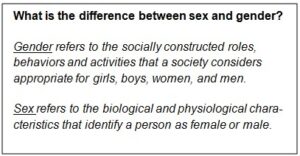Sex and Gender: How Data Disaggregation is Central to Improvement
By Elizabeth Romanoff Silva, MPA on June 2, 2014
What is the best way to integrate gender effectively into an improvement program? Taking gender considerations into account in the program design, monitoring and evaluation aspects of a program is critical to integrating gender. Through the USAID ASSIST Project, we integrate gender into improvement starting in the planning phase, with each country office developing a specific gender integration strategy in each yearly work plan. Conducting a gender analysis in the planning phase of a program helps staff to identify gender-related barriers or issues that can affect the program and its improvement aim before it begins, and to design a more effective and equitable intervention.
 Collecting and analyzing sex- and age-disaggregated data is also critical to integrating gender effectively. Without this stratified data, improvement teams can’t accurately analyze differences in how males and females access and benefit from services and respond to those differences to improve project aims and health outcomes. Many gender-related inequalities in accessing and utilizing health care services can only be identified through analyzing data separately for males and females.
Collecting and analyzing sex- and age-disaggregated data is also critical to integrating gender effectively. Without this stratified data, improvement teams can’t accurately analyze differences in how males and females access and benefit from services and respond to those differences to improve project aims and health outcomes. Many gender-related inequalities in accessing and utilizing health care services can only be identified through analyzing data separately for males and females.
Disaggregating data by sex is not easy though, and this is especially true for improvement work. Because our improvement teams are often collecting monthly data on many indicators, data sets are already complicated, and disaggregating the data by sex doubles the size of the datasets and requires a substantial additional time investment to record the information. Additionally, our teams work with local, implementing partners, who are often responsible for data collection and reporting, so our staff are not directly collecting and reporting the information themselves.
But because our ASSIST team understands that collecting and analyzing sex-disaggregated data is so central to all improvement work because it’s directly tied to improving outcomes, we work together to make it happen. Our research and evaluation team provides support to our field offices and improvement teams to develop tools which have built-in mechanisms to support the collection of disaggregated data and gender-sensitive indicators, and the analysis of those findings. Our field offices work with other implementing partners to promote sex-disaggregated data collection, and our gender integration team provides support to field offices and technical teams in the analysis of the data, and to propose changes to test to overcome barriers that one group faces to accessing or benefiting from services to close the gap and improve health outcomes. This helps our USAID ASSIST team to decide on the highest impact interventions to carry out which are effective, equitable and beneficial for women, men, girls and boys.
Learn more about gender considerations in monitoring and evaluation, and view relevant resources here.